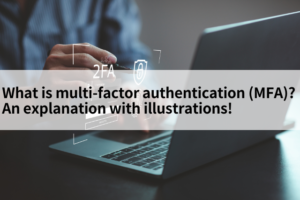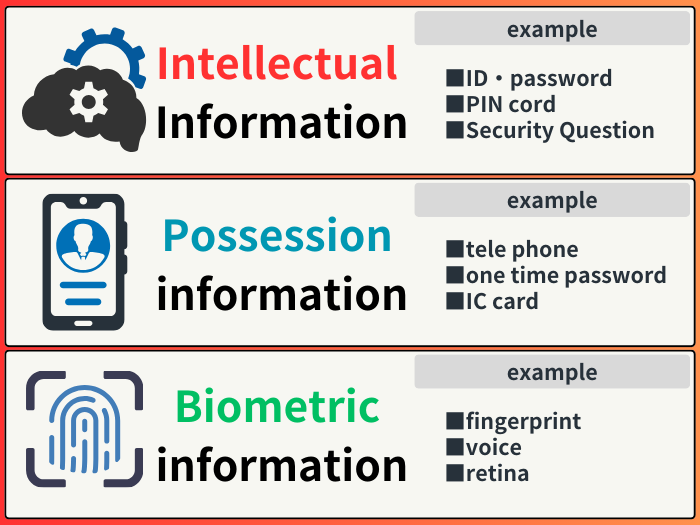[Easy-to-understand explanation] What is multi-factor authentication (MFA)? Explained with illustrations!


Multi-factor authentication has been gaining attention in recent years, but do you know why? In fact, it has been introduced to many users after it was discovered that there are security risks associated with cloud services such as SaaS and the advancement of digitalization.
Multi-factor authentication has been gaining attention in recent years, but do you know why? In fact, it has been introduced to many users after it was discovered that there are security risks associated with cloud services such as SaaS and the advancement of digitalization.
In this article, we will define what multi-factor authentication is and provide an easy-to-understand explanation of its merits and digital aspects.
Table of Contents What is multi-factor authentication? Background to the need for multi-factor authentication Merits of multi-factor authentication |
What is multi-factor authentication?
Multi-factor authentication (MFA) is an abbreviation for Multi Factor Authentication, and refers to a method of authentication that combines two or more of the three factors: “knowledge information,” “possession information,” and “biometric information.” Speaking of authentication, when you sign in or log in to Windows or a smartphone, you are probably asked for your account name and password, and these account names and passwords are considered “knowledge information” out of the three factors. Therefore, multi-factor authentication is achieved by authenticating “possession information” or “biometric information” in addition to authenticating the knowledge information that you regularly use.
About the three factors
We will explain the three factors of multi-factor authentication in detail. To simplify it, they are as follows:

Intellectual information
Intelligent information is authentication information that only you know. It is also the most commonly used authentication method in our private lives, and includes entering your ID and password, PIN code, and secret questions.
Possession information
Possession information is something you own that proves who you are. For example, possession information includes IC cards, mobile phones or smartphones, and one-time passwords.
Biometric information
Biometric information is a method of authentication that utilizes your own body. This is also an authentication method that has been adopted frequently in recent years, and includes fingerprint authentication, face authentication (retina), and voice authentication.
Background of the need for multi-factor authentication
The need for multi-factor authentication is driven by the need to prevent unauthorized access to systems and services and cyber attacks, which have been increasing in recent years. For example, there was a period when SNS account hijackings were common, but these were cases in which security measures were implemented based on only one factor (mainly intellectual information), resulting in many victims. A measure adopted to solve this issue was to meet two factors: the “intellectual information” of the ID and password, as well as the “possessed information” of the one-time password, which helped to prevent the damage from spreading. This authentication is also the second factor of multi-factor authentication.
Merits of multi-factor authentication
The merits of multi-factor authentication are as follows:
|
Strengthened security
By doubling authentication with two or more factors, security can be greatly improved. A state in which security measures are not implemented means a state in which cyber attacks and viruses are easily invaded, but multi-factor authentication can greatly reduce security risks. According to a Google survey (※1), multi-factor authentication can prevent approximately 90-100% of attacks that cannot be prevented by IDs and passwords.
※1 Source: Google Japan Blog “Latest research results: Basic methods to prevent unauthorized use of accounts and their effectiveness”
https://japan.googleblog.com/2019/05/new-research-how-effective-is-basic.html
Improved convenience
With multi-factor authentication, you don’t have to remember your ID and password over and over again, so you can focus on your work.
Demerits of multi-factor authentication
The demerits of multi-factor authentication are as follows:
|
Increases in effort
This only applies to those who have only authenticated with one factor, but since you have to authenticate twice, it increases the effort. However, this extra step significantly reduces security risks, so it is also a question of whether to take the risk or the convenience.
Costs will be incurred
Since a new system will be introduced, costs will be incurred. The cost will vary depending on the number of users, but it seems that it is not a cheap amount. In particular, multi-factor authentication services, which require construction, will incur costs, so we recommend collecting information from various companies and introducing a multi-factor authentication service that suits your company.
Lastly
This time, we have provided an easy-to-understand explanation of multi-factor authentication.
In today’s world, where many cloud services such as SaaS have appeared, the demand for multi-factor authentication services to ensure safety is increasing year by year. Companies that have introduced teleworking or are considering introducing it in the future should take the utmost care, as they do not know where information may be leaked. As part of this, by introducing multi-factor authentication and working to strengthen security, concerns about information leaks can be minimized.
Applippli has also published a website for its multi-factor authentication service, “applippli-key.” If you are interested, please visit the website via the link below.
